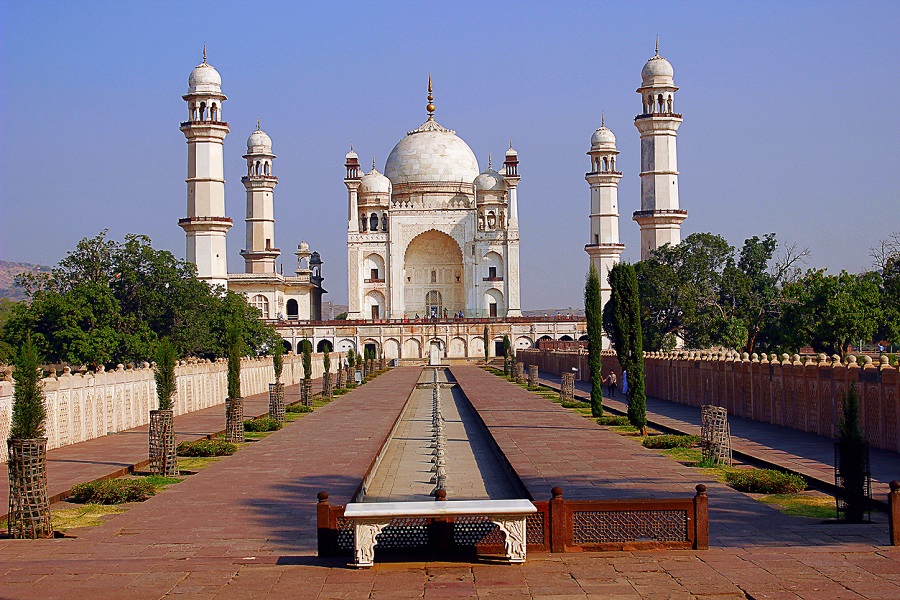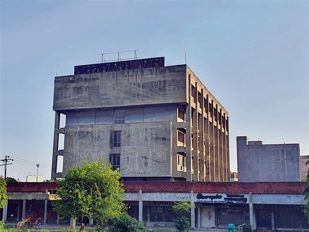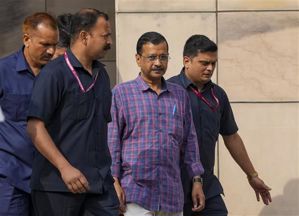
It is one of the world’s most renowned monuments and a magnet to countless tourists from all around the world who visit it each year. Built some 400 years ago, it is a milestone in the architectural history of India. It’s grand and magnificent (think, poetry frozen in time), a great symbol of love built by the Mughal Emperor Shah Jahan in the memory of his beloved wife Mumtaz Mahal. We are, of course, talking about the Taj Mahal. And there’s no Taj Mahal but Taj Mahal!
Or is there?
Well… surprise, surprise! There’s a mini Taj Mahal in Aurangabad in Maharashtra — quite far away from its world-famous, widely celebrated cousin in Agra.
It might be known as a clone of the Taj, but there’s much, much more to this monument.
Tucked between the lofty Sihyachal ranges of the Deccan plateau, Bibi Ka Maqbara, or Tomb of the Lady, stands gracefully on the road between Daulatabad and Aurangabad. Just like the Taj Mahal, it was also built in the memory of a Mughal queen. Do you want to know who? Read on to find out!
WHO WAS 'BIBI'?
Commissioned in 1660 by Mughal Emperor Aurangzeb, Bibi Ka Maqbara was erected in memory of his wife, Dilras Banu Begum, known as Bibi, or a woman of nobility, by her son Azam Shah. After her death, Dilras Banu Begum was given the title of Rabia-ud-Durrani (Rabia of the Age), after an Iraqi noble lady, Rabia Basri, who was known for her benevolence.
The story of Dilras Banu is almost like a fairy tale. She was born in the royal family of Iran and was the daughter of Shahnawaz Khan, who was the then viceroy of the state of Gujarat. She married Aurangzeb in 1637 and became his first wife. History says that Aurangzeb and Dilras Banu’s wedding was one of the most extravagant and astounding weddings of the time.
Also Read: Chandipur Beach — The Hide-and-Seek Beach
They had five children and after delivering her fifth child, Dilras died-uncannily enough, just like her mother-in-law and Aurangzeb’s mother, Mumtaz Mahal.
Both Aurangzeb and his eldest son Azam Shah were grief-stricken and went into mourning. For months altogether, they neither appeared in public nor administered the affairs of the state. It took great efforts for them to come out of their loss.
It was in 1660, three years after she passed away, that Aurangzeb decided to build a mausoleum for his wife, on the lines of the Taj Mahal-the great monument that Aurangzeb’s father had built.
A SPITTING IMAGE OF THE TAJ
Who shrunk the Taj Mahal? That’s the first thought that comes to mind on spotting Bibi Ka Maqbara, which is almost half the size of the Taj Mahal in Agra.
It draws its inspiration from the famous Taj Mahal of Agra and was conceived by Attaullah Rashidi, one of the three sons of Ustad Ahmad Lahori, the chief architect and the mastermind behind the Taj Mahal, who had been given the title of Nadir-ul-Asar (A Rare Gem of the Period) by Shah Jahan himself.
Attaullah had apprenticed under his father while he was working on the Taj Mahal and had gathered valuable experience.
CAN A MONUMENT BE RELOCATED?
A story goes that, in 1803, Nizam Sikander Jah annexed Aurangabad to his kingdom and was so captivated by Bibi Ka Maqbara that he wanted to relocate the mausoleum to the capital city of his kingdom, Hyderabad.
He even ordered his men to dismantle the structure, slab by slab. But then, he had a premonition that if he shifts the structure, some disaster might befall him. He stopped the work, and as a penance, got a mosque built, which still stands to the west of the main structure.
He was an expert in metal designing and also knew Sanskrit and Persian. In fact, he translated a book by Bhaskaracharya (the great Indian mathematician and astronomer) on mathematics from Sanskrit to Persian.
Attaullah was helped by Hanspat Rai, an expert on construction material and its use. Both Attaullah and Hanspat oversaw the construction of the entire structure.
But unlike his father Ahmad Lahori, Attaullah had to work on the structure on a shoestring budget given to him by Aurangzeb. According to inscriptions on the southern gate of the structure, the project cost was `665,283 and 7 annas (a currency unit formerly used in India and Pakistan, which is equal to one-sixteenth of a rupee), while the Taj Mahal was built on a lavish budget of `32 million at that time.
This clearly shows that Bibi Ka Maqbara was a more budgeted exercise than the Taj Mahal. And quite obviously so…for Prince Azam was not Shah Jahan, neither in power nor in riches.
Considered to be the golden age of the Mughal Empire, Shah Jahan’s reign was a prosperous one. Emeralds, sapphires, rubies, diamonds and all sorts of precious stones were mined from Indian soil during his time and his coffers had been bursting with riches, allowing him to commission the most spectacular examples of Mughal architecture.
Azam Shah, however, lacked the treasury his grandfather had access to, as well as the skilled labour that big money could buy.
He had to do with whatever money was doled out to him grudgingly by his penny-pinching father Aurangzeb, who was known for his austere lifestyle and tightfistedness, quite unlike the opulence that characterized his predecessors.
Aurangzeb had little interest in architecture and was not at all in favour of building a monument as lavish as the Taj. But Aurangzeb’s son Azam was determined to have a monument to his mother’s name that might vie with the Taj.
Somehow, Azam Shah pursued his father, who eventually relented. And the maqbara, or the mausoleum, was completed in about a decade of the Begum's death (unlike the twenty-odd years that the Taj Mahal took).
SAME SAME, BUT DIFFERENT
Bibi Ka Maqbara stands at the centre of an enclosed space which is 458 metres by 275 metres. It has ponds, fountains, water channels and broad pathways. It is built on a raised square platform with four minarets at its corners and stairs on three sides, which lead to the tomb, exactly like in the Taj Mahal.
The Mughal architects laid great importance on having a river or a stream pass through the monuments they erected, and Bibi Ka Maqbara is no different. Just like the free-flowing Yamuna River was an integral part of the design of the Taj Mahal, the Kham River, which originates from the Lakenvara Hills in the Satara mountain range of Maharashtra, flows behind Bibi Ka Maqbara.
It also has a charbagh-style garden and a pavilion with twelve doors to allow the free flow of air — both of which are common features in Mughal architecture.
The pathways are decorated with trees on both the sides. There is a water pool and the centre of the pathway consists of fountains and broad reservoirs. To the west of the mausoleum is a mosque and facing the east is Aina Khana, or the mirror chamber, which has mirrors fixed on its doorway.
The Taj has been constructed completely in marble; even its entrance structure, which is made of red sandstone, is interspersed with marble. But Bibi Ka Maqbara-except for the small central portion of the main mausoleum and the dome-is constructed in red sandstone, lime and stucco plaster-the reason why the walls of the Maqbara are a little dusky as compared to the Taj.

inside the Bibi Ka Maqbara, Aurangabad
Bibi Ka Maqbara also has an onion dome, just like the crowning glory of the Taj Mahal, but the dome of the maqbara is smaller than the dome of the Taj.
The white dome of the maqbara has panels adorned with intricate designs of flowers.
However, these drawings are quite different from those in Taj Mahal. At the centre of the mausoleum is a humble grave surrounded by an octagonal lattice screen of white marble. But the mausoleum doesn't boast of semi-precious stones inlaid in the design, or gold plating-riches that once lured raiders to the Taj.
Whatever the differences and similarities between the Taj and Bibi Ka Maqbara, each of the two monuments has its own grace and charm.
Though Bibi Ka Maqbara looks strikingly like the Taj, it is a pleasant construction by itself. Surrounded by a colourful garden, with tall cypress trees, huge mango trees, and colourful rose bushes and seasonal flowers, it gives a beautiful view of the city. And what adds to its glory is that it is the only monument erected by the Mughals in the Deccan and, hence, is also referred to as the Taj of the Deccan.
THE INSPIRATION BEHIND THE TAJ
Now, we know that the Taj has inspired a bevy of structures. But do you know which structure inspired the Taj? The Humayun’s Tomb in Delhi! Commissioned by Mughal Emperor Humayun’s wife, Hamida Banu, in 1565, in the memory of her husband, it was the first garden- tomb in India.
Though it is built in red sandstone, the structure looks similar to the Taj Mahal and it’s believed that it inspired several major architectural innovations that culminated in the design of the Taj Mahal.
THE TAJ AND THE MINI TAJ
Though separated by time, magnitude and distance, the Taj and the Mini Taj (aka Bibi Ka Maqbara) are related to each other in more ways than one. Both Taj Mahal and Bibi Ka Maqbara are great symbols of love and loss.
While the first memorial, Taj Mahal, was built by Shah Jahan for his beloved wife and Aurangzeb’s mother, Mumtaz Mahal; the second, Bibi Ka Maqbara, was built by Aurangzeb and his son Azam Shah in the memory of Aurangzeb’s wife and Azam’s mother, Dilras Banu-two gracious ladies who were known for their generosity, kindness and charitable nature, immortalizing them in the chapters of history…
— Excerpted from A Dozen and a Half Stories - Strange and Mysterious Places the World Forgot by Arti Muthanna Singh and Mamta Nainy, with permission from Rupa Publications
Also Read:The Temple with Musical Pillars
Khooni Darwaza — The gate with a blood-stained history
A Relic of St. Philomena of Italy In India?
Phugtal Monastery: The Honeycomb Monastery
The Hanging Pillar of Veerabhadra Temple
Lonar Crater Lake — The lake that casts moon magic
Join Whatsapp Channel of The Tribune for latest updates.


























